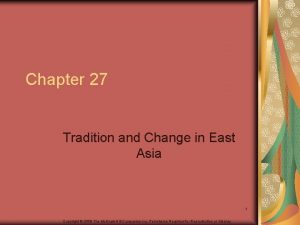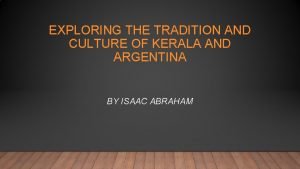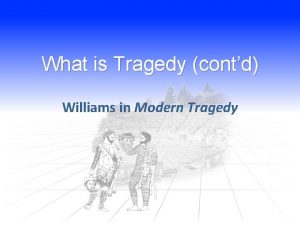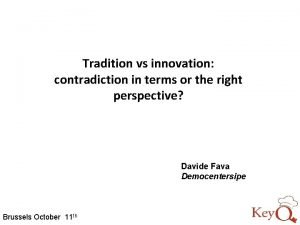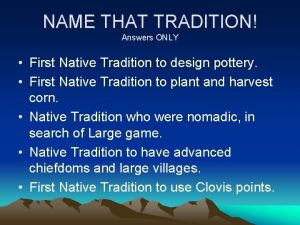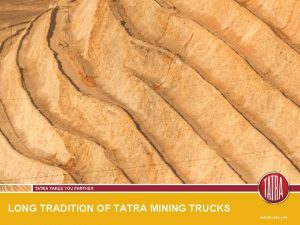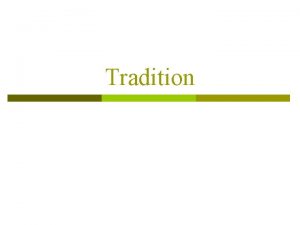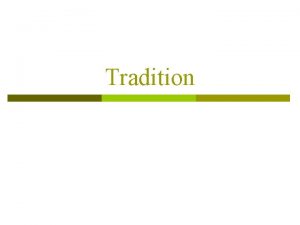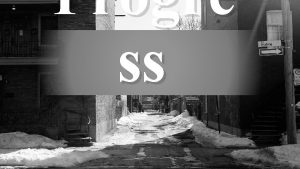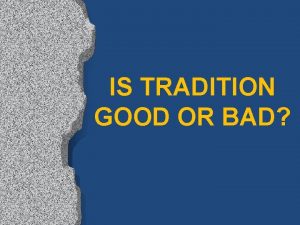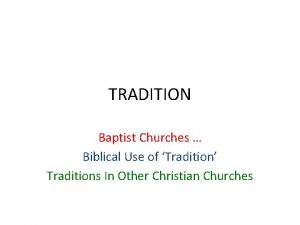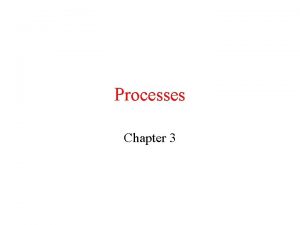Media and Processes Chapter 2 6 The Tradition










































- Slides: 42

Media and Processes Chapter 2. 6 The Tradition of Craft

Art or Craft: What’s the Difference?

Utility vs. Aesthetic

Hanbok, a traditional Korean dress worn with shoes and a hairpin by women of the upper and royal classes. Fig. 2. 6. 1. Hyo-In Kim, To Be Modern #2, 2004. Metal screen, wire, porcelain, acrylic paint, and found objects, slightly over life size.

Fig. 2. 6. 2. Hyo-In Kim.

Ceramics From Greek word Keramos, meaning “pottery. ”

• Earthenware = often red in color and hardens at a lower temperature than other clays. • Stoneware= is much harder than earthenware and is fired at a higher temperature. • Porcelain= a durable, high-temperature ceramic commonly used for dinnerware. It is made of a mixture of feldspar, kaolin, and silica. • Greenware= dried clay that is very fragile. • Bisqueware= fired clay that is permanently hardened and cannot be wetted and returned to a soft-clay state.

Wedging

Fig. 2. 6. 3 a. Working with clay: spiral wedging technique.

Fig. 2. 6. 3 b. Working with clay: slab method.

Throwing

Fig. 2. 6. 3 c. Working with clay: throwing.

Coil Method Rolling the clay on a flat surface so that it extends into a long, rope-like shape. Throwing Turning the clay on a potter’s wheel consisting of a round disk that revolves while the ceramist shapes the object.

Fig. 2. 6. 4. Seated Figure, Oaxaca, Mexico, Zapotec style, 300 BCE-700 CE. Ceramic.

Fig. 2. 6. 5. Porcelain Flask with decoration in blue underglaze. Ming Dynasty, 1425 -35.

San Ildefonso-Style Pottery A pottery tradition of the Tewa people in Southwestern North America (New Mexico)

Fig. 2. 6. 6. Maria Martinez, San Ildefonso Pueblo, New Mexico.

Fig. 2. 6. 7. Julian Martinez, San Ildefonso Pueblo, New Mexico.

Fig. 2. 6. 8. Maria Martinez and Julian Martinez, bowl with plumed serpent, ca. 1925. coiled and burnished earthenware.

Slab Method

Fig. 2. 6. 9. Peter Voulkos, Gallas Rock, 1960. Stoneware with slip and glaze.

Glass Made of Silica and lead and heated at high temperatures.

Fig. 2. 6. 10. Portland Vase, Roman, ca. 1 -25 CE.

Fig. 2. 6. 11. Rose window and lancets, north transept. 13 th century, Chartes Cathedral, France.

Fig. 2. 6. 12. Dale Chihuly, Fiori di Como, 1998. Hand-blown glass and steel.

Dale Chihuly, The Olympic Tower, 2002. Abravanel Hall, Salt Lake City, Utah.

Metalwork

Chasing= hammering the surface of the metal until a desired shape and texture is imprinted on the metal. Repoussé= hammering against the back of the image to create a relief in the image.

Fig. 2. 6. 13. Death mask from Shaft Grave V, Grave Circle A, Mycenae; also known as Mask of Agamemnon, ca. 1550 -1500 BCE. Gold.

Fig. 2. 6. 14. Chalice with Apostles Venerating the Cross, ca. 600 CE, Syria [Byzantine]. Silver repoussé, partial gilt.

Fig. Benvenuto Cellini, Salt Cellar of Francis I, 1540 -43. Gold, enamel, ebony, and ivory.

Fiber Threads made from animal or vegetable materials (such as fur, wool, silk, cotton, flax, or linen), or more recently, synthetic materials (such as nylon or polyester).

Fig. 2. 6. 16. Mary Linwood, detail from Hanging Partridge, late 18 th century. Crewelwork embroidery.

Fig. 2. 6. 17. Faith Ringgold, Tar Beach, 1988. Acrylic on canvas, bordered with printed, painted, quilted, and pieced cloth.

Embroidery

Fig. 2. 6. 18. Tlingit Chilkat dancing blanket, 19 th century.

Fig. 2. 6. 19. Toshiko Horiuchi, Mac. Adam, Knitted Wonder Space II, 2009. Braided nylon 6 -6, hand crochet.

Wood

Intarsia, a decorative wood technique, a kind of wood mosaic

Fig. 2. 6. 20. Detail of Studiolo from the Ducal Palace in Gubbio, Italy, Giuliano da Maiano, after a design by Francisco di Giorgio Martini, ca. 1480. Walnut, beech, rosewood, oak, and fruit woods in walnut.

Fig. 2. 6. 21. Captain Richard Carpenter, Bent-corner chest, ca. 1860. Yellow cedar, red cedar, and paint.

Fig. 2. 6. 22. Andrew Early, turned bowl, 2010. Indian mahogany.
 Concurrent in os
Concurrent in os Chapter 27 tradition and change in east asia
Chapter 27 tradition and change in east asia Chapter 27 tradition and change in east asia
Chapter 27 tradition and change in east asia Chapter 26 tradition and change in east asia
Chapter 26 tradition and change in east asia Chapter 27 tradition and change in east asia
Chapter 27 tradition and change in east asia Designing and managing service processes
Designing and managing service processes People in media vs people as media examples
People in media vs people as media examples Kerala culture and tradition
Kerala culture and tradition Elements of folktales
Elements of folktales Tragedy and contemporary ideas by raymond williams
Tragedy and contemporary ideas by raymond williams Tradition and innovation quotes
Tradition and innovation quotes T. s. eliot tradition and the individual talent
T. s. eliot tradition and the individual talent Hình ảnh bộ gõ cơ thể búng tay
Hình ảnh bộ gõ cơ thể búng tay Slidetodoc
Slidetodoc Bổ thể
Bổ thể Tỉ lệ cơ thể trẻ em
Tỉ lệ cơ thể trẻ em Chó sói
Chó sói Thang điểm glasgow
Thang điểm glasgow Hát lên người ơi alleluia
Hát lên người ơi alleluia Các môn thể thao bắt đầu bằng tiếng bóng
Các môn thể thao bắt đầu bằng tiếng bóng Thế nào là hệ số cao nhất
Thế nào là hệ số cao nhất Các châu lục và đại dương trên thế giới
Các châu lục và đại dương trên thế giới Công của trọng lực
Công của trọng lực Trời xanh đây là của chúng ta thể thơ
Trời xanh đây là của chúng ta thể thơ Mật thư tọa độ 5x5
Mật thư tọa độ 5x5 Làm thế nào để 102-1=99
Làm thế nào để 102-1=99 Phản ứng thế ankan
Phản ứng thế ankan Các châu lục và đại dương trên thế giới
Các châu lục và đại dương trên thế giới Thể thơ truyền thống
Thể thơ truyền thống Quá trình desamine hóa có thể tạo ra
Quá trình desamine hóa có thể tạo ra Một số thể thơ truyền thống
Một số thể thơ truyền thống Cái miệng xinh xinh thế chỉ nói điều hay thôi
Cái miệng xinh xinh thế chỉ nói điều hay thôi Vẽ hình chiếu vuông góc của vật thể sau
Vẽ hình chiếu vuông góc của vật thể sau Nguyên nhân của sự mỏi cơ sinh 8
Nguyên nhân của sự mỏi cơ sinh 8 đặc điểm cơ thể của người tối cổ
đặc điểm cơ thể của người tối cổ V cc
V cc Vẽ hình chiếu đứng bằng cạnh của vật thể
Vẽ hình chiếu đứng bằng cạnh của vật thể Phối cảnh
Phối cảnh Thẻ vin
Thẻ vin đại từ thay thế
đại từ thay thế điện thế nghỉ
điện thế nghỉ Tư thế ngồi viết
Tư thế ngồi viết Diễn thế sinh thái là
Diễn thế sinh thái là


